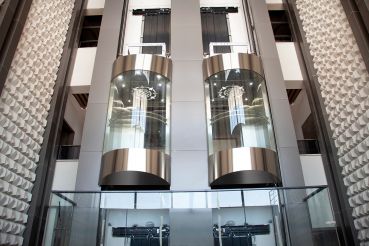HqO’s Chase Garbarino On the Intersection of Proptech and Human Resources
How owner and occupier execs, along with HR, are using technology to navigate the return to office
By Philip Russo September 19, 2023 9:00 am
reprints
In the grinding effort to bring workers back to the office, owners and occupiers are searching for ways to meet complex and often unprecedented worker needs and expectations.
Among the proptech companies attempting to help both groups during this difficult journey is Boston-based HqO, which provides technology to connect people with each other and the places they work.
Chase Garbarino, co-founder and CEO of HqO, has many ideas and strong opinions as to what both sides are doing — and still need to do — to bring some stability to the office market.
In late August, Garbarino spoke with PropTech Insider about his overall view of the return to office and the myriad factors that are driving owners and occupiers to “group therapy” sessions with HqO.
The interview has been edited for length and clarity.
PropTech Insider: Let’s start with the big picture: What is the intersection of proptech and human resources?
Chase Garbarino: Everybody in the working world is pretty aware of the tension between HR management and employees in companies. In the return to office today, the C-suite and executives are trying to thread the needle more and more. You saw it with Zoom the other day, with Meta and Facebook — they just cracked down even harder on their return to office policies.
Obviously, this is not your traditional global heads of real estate facilities, folks. This tends to cross the line into HR. In the eyes of employees, work from home has become the ultimate benefit. So, if you’re taking away an employee benefit that they’ve particularly become accustomed to over the last couple of years, this becomes a very heightened issue around what employers are trying to do for the employee experience and how they need to think about this as an employee benefit.
A lot of folks are turning to the real estate side of the house, to proptech as an answer for this. The answer used to be you go to an office because it’s the way we do business and nobody questioned it. Now I think HR leaders are picking their heads up saying, “We have a significantly more disgruntled employee base, my compensation is tied to retention, but we also need to bring them back, so how can I work with the real estate and facilities teams and what kind of solutions do we have to make it so that people aren’t too upset about coming back?”
This is the No. 1 issue for so many companies with regards to their human capital. And I think proptech can step in and be part of the solution in finding the right balance for companies on how to handle this.
Do you see more companies insisting that workers return to the office, even if it’s at least three or four days a week right now?
Yeah, overwhelmingly, you’re seeing significantly more. This was always our point of view, which I don’t think was rocket science to predict, but it has come true. Nobody wanted to go first.
Jamie Dimon [CEO at JPMorgan Chase] and some of those people can pull it off. Companies did not want to come off as the insensitive employer that’s bringing people back. So once [Mark] Zuckerberg, Elon Musk and Dimon — very well-known celebrity executives — started to bring people back there was a bit of a groundswell. I think you’re seeing significantly more companies do it.
You will find a number of companies saying, “We’re going to lean in very hard to complete flexibility,” but I think most of those companies had that point of view pre-pandemic. A very big tech company like Atlassian, which had that policy beforehand, is now running a lot of PR around that, but it was always going to be a bit of a herd mentality. I think one of the funniest things is when companies try to not use the M-word, — quote unquote, mandate. If you’re going to do it, at least be honest about it.
So working from home remains firmly in the mix?
One of the consistent things you see in the announcements about companies wanting a return to the office is that they’re very rarely calling out what days of the week. There’s some flexibility on when during the week. I think most employers, particularly the HR departments, are saying, “If you’re a parent with young kids or just anybody that has a doctor’s appointment, whatever it is, life happens. We want to give our people some flexibility on when they come in.”
The whole point of coming back is to be around other people. If the people you need to be around are on different days, that’s going to be challenging. Naturally, you can take Friday off the board because most people are working from home on Friday, but there’s still more decision-making and coordination that’s been pushed down on people. We’re also seeing that there is a sense of employees to some degree saying, “Look, we just really want it clear — because we know you want us back — but if you don’t make clear what the expectations are, it’s very hard for us to comply.”
HqO reaches more than 700 of the Fortune 2,000 companies through our platform. A lot of them would like to provide a lot more flexibility on location. There aren’t a ton of people outside of big offices, where you’ve put a lot of investment into making them special and purpose-built for your employee base. What I continue to hear from large employers and even smaller employers is they really care about their people being together. It’s not necessarily like we need them in Midtown West or Wall Street, but we want them together. Are there more flexible options for them to tap into — like all this talk about the hub-and-spoke model, where you provide access to spaces in certain downtown areas and farther out in metro areas?
I think a lot of employers would embrace those solutions, but the industry has to put in some work to be able to provide greater optionality on how their customers can access great spaces.

It sounds like the burden to some extent is on the employees to make this all work. But, on the management side, are they putting all the pressure on HR to make the return to work flexibility happen?
It’s going both ways. One of the things that I see that I think is very well intended but potentially a mistake is that they’re trying to give autonomy to frontline managers for their team. My first inclination is to give managers freedom to do that, but what happens is that tension tends to build up over time when you have one manager who has a different policy than another. That can create internal conflict with the people on those teams. By pushing down the decision-making to the individual managers, it can create problems within different pockets of the company.
If you have a broad blanket mandate, it makes it easier, taking a certain amount of decision-making and brain damage off the table. You don’t necessarily have to spend your time as a frontline manager explaining your decision. But it does feel like you’re taking a certain autonomy away from them. It’s pretty complicated.
I think managers can be put into a very difficult position if they’re coming up with policies that traditionally would have been decided by the executives and HR. It’s putting a lot of pressure on managers where they might not necessarily be positioned to succeed.
And, by managers, you’re including HR managers?
No, basically everybody but HR. I think HR and executives need to come up with much clearer policies. Not everybody’s going to like the policy, but everybody would opt for clarity over ambiguity any day of the week. If there’s penalties or you’re bonusing people or treating them differently than those who come in or don’t come in, then it needs to be a formalized policy. I think taking the medicine, if you will, getting through it, and having a better relationship with employees works rather than people who are trying to have their cake and eat it too — “We want to be liked and we don’t want to tell you these things, but we’re also going to give opportunity to the people that come in.” It feels disingenuous.
Is HR caught in the middle here trying to make this work between the executives and workers?
It’s an incredibly hard position for them. And it’s an incredibly hard position both for the real estate side and HR, where obviously real estate is looking at their big expense on the profit and loss statement and spending all this money on the thing that they manage.
Meanwhile, HR, oftentimes their compensation is tied to employee retention, satisfaction and engagement. We tend to underestimate how wildly disruptive shutting the world down for a couple of years was, and then trying to reset it. Everybody’s gonna go through some pain in that. It’s incredibly difficult for HR when not only do you have this global pandemic that completely changed how we work, but then marry it with a zero interest rate environment where employees are just making more and more money, with the grass is always greener attitude where they can just jump over there. And HR is told by the executives to retain the talent at all costs. It’s a very, very difficult job right now.
Is there technology available to HR to handle all these pressures and changes?
I think there are a couple of buckets of technology. You have the overall facilities management technology. That is, how do we manage the square footage and locations that we have and the assets within those. Now you have all these people where the question is how often and when they come in. It’s a completely different paradigm for the facilities people and HR.
And then HR is all about the sentiment of the employees, the productivity of employees as it bridges to their managers, and their retention numbers around talent. All of this stuff on the facilities side has become the thing employees are most concerned about: “I’ve been working at home for a couple of years now, and my whole work setup is personalized exactly the way that I like it, and you’re making me come back for an obscure amount of days.”
So, for management it has become, “How do we operationally manage this and where do all these new things sit in terms of ownership and accountability?” We just did an event with the CRE Leadership Forum where we bring in global heads of real estate. Just to kick off the meeting, we asked, “Who reports to a global head of real estate, or, if you are more senior, who reports to a CFO, and then who reports to HR?” It was completely evenly split. Different companies have different people reporting to finance and HR, which I think is an indication of how these things have changed. When we’re thinking about the future of work, the job of these folks, no one really has a super clean playbook on it.
There seems to be no denying the gravitational pull back to the office. Are companies still behind the curve in using technological tools to help implement that?
I think we’re on the frontier of all of this, which sits between those of us who are in the business of commercial real estate and the occupiers for whom it’s a means to an end in terms of it being a very large line on their profit and loss.
We’ve never been particularly sophisticated about measuring the impact of the office in a very quantitative way. The really big picture here is that we have the largest asset class on the planet, and it’s never really been quantified that the customer drives the bottom line of their business. I think that’s now going to become highly scrutinized.
It already is, right? We’re seeing it in the leasing data. The whole opportunity and challenge is going to be the people who embrace that. We see this in our business — the people who embrace it and really want to try to show the value it delivers for tenants and their employees are ultimately going to win and win pretty big because you’re seeing that in the flight to quality already. Those that are just hoping and praying that it goes back to the way it once was — I would short every single one of those groups if I could.
I don’t think this is purely a cyclical shift. I think it’s a secular shift in the sense that interest rates go up and down, and we know how that impacts real estate. The conversation is now around how employees feel about this. You can’t bank on the CEO and the CFO knowing how we’re going to make these things work. The C-suite and HR are much more heavily involved now in terms of thinking about how the office supports their HR initiatives of engaging these people. Anyone in real estate not leaning heavily into the individual metrics of how employees are supported by the office — if I were an investor, I would not be putting my money into that real estate group.
Given all that, has HqO’s role changed now?
Our role does change. We own the largest data set — 1.3 million employees at a lot of very large Fortune 2,000 companies — kind of the standard assessment of how they feel about their workplace. We have the industry standard data model and assessment base of large tech companies concerning what their employees say is important to them about the office and how they’re currently supported in those things.
Originally, it was an offering for the employers because it was their relationship with the employees. Now we’re providing this service to the real estate operators because the employers are coming to us saying, “Look, our employees have certain needs out of the property and we don’t control those things. We need our real estate partners to take action on these with us. If they don’t, we’re not going to stay with them. We’re going to go to other people that will be our partner in what is an incredibly challenging time of getting our employees back to the office.”
We’re servicing the employers and the real estate operators, which we think is the critical thing moving forward, getting these two to work together much more closely. Real estate groups and operators need to think of themselves significantly more so as service providers, particularly to those HR folks. Because they’re the ones that hold the keys to policy and mandates and all that stuff on how we ultimately repopulate offices.
Facing such a complex scenario, who is asking for your work more these days: owner operators or tenants?
Oh, man, it changes every 24 hours. One day we’ll have an influx of operators coming in saying, “We get this. We need to be more consumer-oriented around the employee.” We put out an invite for these commercial real estate leadership forums for employers and occupiers, and they fill up within 24 hours. It’s basically like group therapy. They get into a room and they just share their issues and talk through how everybody is dealing with this unprecedented scenario where we have employee productivity in the U.S. down five or six quarters in a row for the first time since the Labor Department has tracked it.
And employee engagement with their companies has trended down. I think loneliness and depression is an issue that we see from employees feeling disconnected. We have a whole generation of Gen Z employees who don’t even really understand how the world of work works because they’ve been left alone in their apartments through no fault of their own.
But that’s a huge opportunity for the people on the real estate side to try to partner. Being customer-oriented almost solves most problems. If you’re able to retain rent, if you’re able to sell to customers, ultimately that’s going to be our way out of this.
Philip Russo can be reached at prusso@commercialobserver.com.


